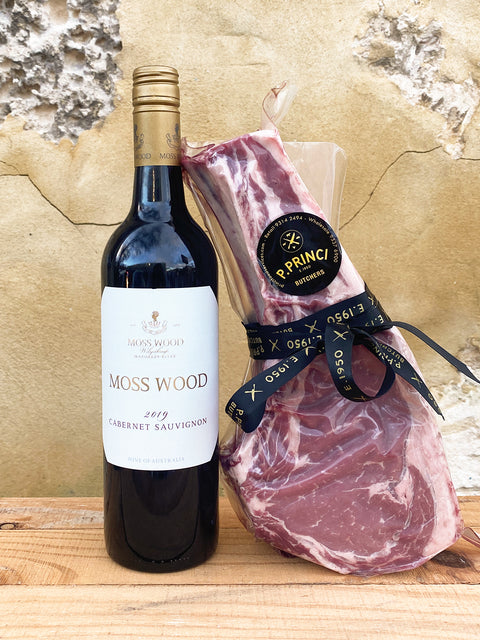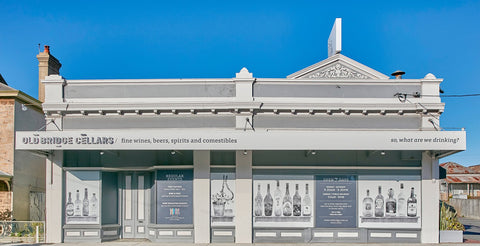Renaissance of Australia’s first planted grape variety.
In our last 'masterclass' newsletter, we focussed on outlining the reasons for the upsurge in the popularity of the wines made from Malbec. Their success in our store is based on a combination of great quality and value. The quality of the Malbec wines now made by wineries such as Bleasdale and Bremerton reflects the recognition that this variety is best suited by far to a moderate Mediterranean and dry climate and to areas not subjected to frosts. The overwhelming importance of the appropriate terroir for the production of great Malbec is paralleled by that of Grenache, which is likewise undergoing a pronounced rise in popularity and the focus of this newsletter.
Grenache was once one of the most important red grape varieties in Australia, but for reasons we will come to later declined in importance in the last century and has only come again to the fore with a greater understanding of the type of terroir on which this type of variety thrives and the most appropriate viticultural and wine making processes. The best of the current Grenache wines are sensational.
Grenache, or Garnacha as it is termed in Spain, is believed to have originated in the warm, dry areas of Spain, where it is the third most planted grape variety. While Grenache has very attractive fruit flavours, it tends to be relatively low in acid and tannin and thus often benefits from blending with other varieties. Thus, although it constitutes the main grape variety in the warm southern Rhone region of France, including often 80 % of the blend of Chateauneuf-du Pape, one of the greatest of red wines, the Grenache wines of that region are enhanced by the inclusion of particularly Shiraz (named Syrah in France) and Mourvèdre. Wines made from a blend of those three grape varieties, termed GSM, have become very popular in Australia.
Shiraz is widely thought of as the main red grape variety of Australia and the crucial role played by the premium wines made from this variety in drawing world-wide attention to the outstanding quality of our greatest red wines. At the instigation of James Busby, who played such a crucial role in initiating Australia as a wine-producing country, Grenache became the first red variety planted in Australia, dating back to the first half of the eighteenth century. Indeed, Grenache and was not replaced by Shiraz as the most planted variety until as recently as the 1960s. In the intervening period, Grenache, with its long ripening period, had facilitated the development of high sugar levels in the grapes of hotter areas, and thus the development of the luscious sweet wines with which Australia had become associated.
Although the influence of the development of GSM blends may have subtly increased the awareness of Grenache in Australia, the huge potential of this grape variety for producing truly outstanding red wines is only now becoming fully appreciated. This recognition is due in particular to the care invested in producing wines that are carefully utilising the unique qualities of the fruit produced on old Grenache vines in the McLaren Vale and Barossa Valley. Steve Pannell at his winery in the former region and Yalumba in the latter have been at the forefront of the renaissance of our “oldest” variety.
Steve Pannell
Steve Pannell is one the most outstanding and innovative winemakers in Australia. He is very forthright in his views on wines and the regions, viticultural and winemaking methods that are most appropriate for each grape variety. He has particularly strong and positive opinions on Grenache, which he holds in the highest regard and for which he has been a major champion in recent years.
Steve makes the point that Grenache is ideally suited to the warm “Mediterranean” climate of McLaren Vale. Because the roots of Grenache penetrate deeply into the soil and thus help sustain the vine during dry summer periods, this variety is particularly well adapted to warm, dry areas. Steve is adamant that that, if treated with the respect it deserves, Grenache does not have to be characterised as producing wines with low acid and tannin. In fact, he particularly likes the “gritty earthy tannins” of his Grenache wines as he considers them so important when drinking those wines with food.
SC Pannell Basso Garnacha 2020
The term “Basso”, used for this delicious Grenache, refers to the minimal use of preservatives. The fruit, which comprises solely Grenache, was hand harvested at an ideal sugar level of 13.5 Beaume. The wine underwent malolactic fermentation in stainless steel tanks and was matured for six months in French vats, then racked and bottled without filtration. Alcohol concentration is 14 %. A fresh medium-bodied red wine that will provide delicious drinking over the next few years.
SC Pannell Old Macdonald Grenache 2020
This wine was made exclusively from Grenache produced by 78 year old, dry-grown bush vines planted in deep sandy soils on the Old Macdonald vineyard. This vineyard is located in Blewitt Springs and thus at the heart of the best land for this variety in McLaren Vale. The fruit, of which 20% consisted of whole bunches, was vinified in small open-top fermenters. The wine was then matured for eight months in large eight year-old French barrels. The perfumed amalgam of different fruits flow on to the succulent, complex palate of this medium-bodied wine that is backed by fine, sandy tannins. An outstanding example of Grenache.
Yalumba wines
Yalumba is Australia’s oldest winery, founded in 1849 by Samuel Smith, a brewer who had emigrated from England two years earlier. Indeed, Yalumba’s vineyards are the oldest in the world, reflecting the catastrophic effects of Phylloxera throughout Europe in the nineteenth century and to which Australia was mercifully not subjected.
The oldest Grenache vines at Yalumba date back to far as 1889 and are still maintained as bush vines, which recognises that they are grown without the use of a trellis. This method was originally employed to reduce the cost of grape production. Ironically, the associated benefit of reducing the likelihood of overcropping has, together with modern viticulture and wine making methods, led in recent years to the production of some truly outstanding wines.
Yalumba Bush Vine Grenache 2020
This wine is part of Yalumba’s Samuel’s Collection, dedicated to Samuel Smith who planted his first Grenache vines under moonlight in the nineteenth century! This 2020 Yalumba Grenache was made from fruit grown on 35-80 old bush vines planted on various plots scattered throughout the Barossa Valley. The plots vary in climate and soil types, which has contributed to the complexity of this wine. It is medium-bodied, vibrant and refined, combining delicious fruit flavours and fine tannins. Ideal for drinking now or over the short term. Fantastic value.
Yalumba Vine Vale Grenache 2021
This superb Grenache was made from grapes sourced from bush vines planted as long ago as 1949 at a special site in Yalumba’s tricentenary vineyard in the Barossa sub-region of Vine Vale. The warmth of the floor of the Barossa Valley floor provides the perfect environment for bush vines to yield generous and concentrated fruit.
The fruit from two blocks were wild-fermented separately, the first comprising entirely whole bunches and the second 30 % whole bunches, an approach that results in increased subtlety. The wine was matured for eight months in older French oak puncheons. This fruit-driven Vine Vale Grenache has an enticing fresh fragrance, displaying strong cherry aromas and a touch of herbs and spice. The generous, velvety and fresh juicy palate is characterised by the presence of red and blue fruits and a pinch of spice and is surrounded by just the right level of acid. The finish is long, refined and silky.
Yalumba the Tri-Centenary Grenache 2018
We have managed to secure a few bottles of this amazing Grenache, which represents a genuine piece of Australian wine history. The wine was made from fruit that was hand-picked in 2018 from 820 gnarled, bush vines that had been planted in 1889 in two acres of deep, sandy loam in the prime Barossa area of Vine Vale. These vines draw water from the underlying red-brown clay and thus during protracted dry periods do not require irrigation.
The ability to dry-grow these old vines and an extended period on skins have played major roles in producing a unique wine of great complexity and excellent texture. The bouquet has an attractive combination of red cherry, raspberry and spice which flow through on to the medium-weight and long palate that is backed by good acid and fine tannins. A great wine!
Swinney
The Grenache wines made by Steve Pannell and Yalumba have utilised very effectively the superbly concentrated flavours of grapes produced by very old vines in the long-established wine regions of the McLaren Vale and Barossa Valley. The wines made by Swinney wines in the Frankland River region of the Great Southern demonstrates that, when handled carefully and appropriately, indisputably great Grenache can also be made from grapes produced on young vines grown in a totally different region and never previously associated with this variety. The Swinney wines have been greeted with universal and ecstatic accolades by wine writers here and in the UK, with their quality and uniqueness drawing special praise from Jancis Robinson.
The area on which the Swinney vineyards is located was purchased by George Swinney in 1922, with later generation siblings, Matt and Janelle, responsible for developing the vineyards and wine organisation. Matt’s love of the wines of the southern Rhone led to the planting of Grenache and Mourvèdre in the late 1990s, despite many wine authorities questioning whether these varieties would ripen optimally in the Frankland region. How wrong those critics were!
Grenache has proved ideally suited to the gravel ironstone hilltops on which the vineyards are located and to the use of dry-grown bush vines. The quality of the fruit is ensured through the care invested by the very experienced viticulturist Lee Haslegrove, with the fruit hand picked and any that is not perfect then rejected. The appointment of Rob Mann as winemaker in 2018 has been absolutely critical to the development of Swinney’s unique and exceptional style of Grenache.
Swinney Frankland River Grenache 2020
The 2020 Swinney Grenache includes a small amount of Mourvèdre (7%) and Shiraz (7%), paralleling the approach widely adopted by wine makers in the Rhone region of southern France The 2020 Swinney Grenache was wild fermented, with 40% comprising whole bunches. After two weeks on skins, it was matured in 600 litre barrels and then bottled without fining and with minimal filtration.
The bouquet of this Grenache comprises a complex blend of plum, raspberry and black cherry aromas. The medium-weight palate has rich and enticing flavours that are complimented by the fine tannins. No wonder some wine writers have referred to this wine as moreish; one glass consumed and the next is soon poured!




